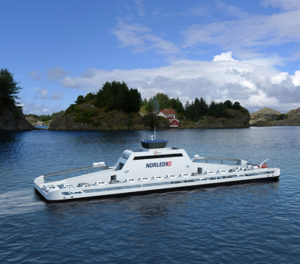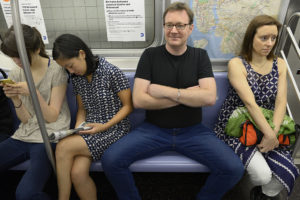In This Issue
Flanigan’s Eco-Logic: Red Light Cameras
Here Come the Electric Ferries
“Reggie” Doubles Down in New England
Grid Reliability
Transit Etiquette
Stanford Reaches for the STARS
Telltale Signs of Climate Change
EcoMotion Intern Perspectives

Flanigan’s Eco-Logic: Red Light Cameras
So I ask you: Is it me getting old and more conservative, or are there more and more people running red lights? And if it’s the latter, and there is more red-light running, won’t there be a lot more crashes?
Or do we all adjust to this tardy behavior? Do we as a society learn to wait a few seconds more when the light turns green, and make sure to look left, and right, before proceeding? Is this because green may not be green at all? Do we need another light to tell people to really stop? How about a double red? Or should orange to be the new red? Some cities extend the yellow a bit with marked results.
Why aren’t cameras the answer? In this day and age, it would seem that yes, only real-time ubiquitous cameras backed up with stiff fines would be the only way to change red-light-running behavior. Red light cameras were removed years ago in California cities, in 2012 where I live; 2013 where I work. Why? Seems that cameras are an integral part of 21st-century security systems. Cameras don’t lie.
Automatic ticketing programs use cameras mounted at intersections that automatically record all cars that are in violation of the red light law. Drivers then get tickets by mail. The use of red light cameras has been challenged as a taking of civil liberties, criticized as “big brother” like. But let’s see: You’re running a red light and could potentially kill people. How many civil liberties do you deserve?
Traffic deaths rise when cities remove cameras… up by 30% according to the Institute for Highway Safety. Its study surveyed 158 communities that removed their cameras, focusing on a sample size of 14 and a control group of 29 cities in the same region that kept their program. Related research found that fatalities were 21% lower in cities with cameras. Hmmm.
The origin of green, yellow, and red traffic signals dates back to 1830s when the system was devised for railroad traffic. Red was chosen as it symbolizes danger. Originally white was used for “go.” (Green symbolized caution.) The use of white ended when several red lenses broke, leaving exposed light bulbs naked and white… and sending the entirely wrong signal.
In the 1860s and in England, increased volumes of horse-drawn traffic warranted the development of a “sephamoric” system, like a railroad crossing using an arm that raised and lowered, the latter to stop. The sephamoric system also included red and green lights for nighttime stop and go. Then in the 1920s, and in Detroit, a policeman named Potts invented the three-lamp traffic signal that is standard today.
So is it just me? Is it just my town? I read a bit and find a reporter writing that running red lights is practically a “municipal pastime” in Reno. There’s a band called the Running Red Lights in Toronto. A self-driving Uber was found running a red light in San Francisco. In St Louis County a top official there called running red lights the “the most pressing traffic issue.” Red-light running is a top cause of auto accidents.
Opponents have claimed that red-light cameras are all about raising money. They are reinforced in their objection by studies that show that red-light cameras cause an increase in rear-end collisions as motorists slam on the brakes to avoid being ticketed. This was the justification for a bill introduced in 2015 in the California Assembly (AB 1160) to ban all such programs that use red light cameras in California. “They’re a hindrance to traffic,” was the rallying cry.
OK, there is data that shows that rear-end collisions went up 80 – 325% at select intersections where cameras were installed. My response: For how long? Give the cameras time to work. Let drivers get used to a new reality, a reality of very stiff fines. They will change. In time they will learn to slow down as soon as they see yellow and prepare to stop.
So what happened? On no, the story leads us to the courts. Ugh. In our neck of the woods, the L.A. County courts refused to prosecute vehicle owners who refused to pay their violation notices, typically $480. The courts put photo evidence in question. The State Court of Appeal, Second District court issued seemingly contradictory rulings. In the meantime, only volunteers paid their fines, and cities were only breaking even after paying taxes and fees to firms like Redflex, an Australian firm that installed and operated systems.
First introduced in the 1980s, by 2014 there had been a large drop in their use. In the 2012 – 2013 time frame, many Southern California cities abandoned their programs and took their red light cameras down. My hometown of Glendale dropped its Redflex system in 2012. In California, 60 cities dropped their camera programs. Nationally, there was a drop from 700 cities nationwide to 500 by the end of 2013. San Diego, El Cajon, Walnut, Murrieta, San Bernardino, Los Angeles, and Pasadena all canceled their programs. Pasadena canceled its red-light camera program in 2012 and also increased the yellow time at its traffic signals. A Texas Transportation Institute study found that a one second increase in yellow decreases accidents by 40%. West Hollywood added three-tenths of a second to its lights.
So what’s the goal? It is to get drivers to stop when the light turns red. Simple. Could we try a carrot approach? Doubt it. Here’s where a big stick is good, where a big stick can save lives. By being firm in our use of today’s most basic security technology – the camera – there can be fewer deaths and injuries on our roadways. We can change bad behaviors.

 Siemens has a long track record with electric boats. Fully 130 years ago, Siemens launched its first electric boats on the Spree River in Berlin. They operated as water taxis in 1886; each Elektra could carry 25 passengers at a speed of 9 mph.
Siemens has a long track record with electric boats. Fully 130 years ago, Siemens launched its first electric boats on the Spree River in Berlin. They operated as water taxis in 1886; each Elektra could carry 25 passengers at a speed of 9 mph.

 U.S. Secretary of Energy Rick Perry sent a memo to staff in April of this year seeking clarity and a review of, “how market-distorting policies are potentially threatening the reliability of the grid.” Many renewable energy advocates feared that this would be another attempt to undercut de-carbonization strategies, another way to intercede the widespread adoption of disruptive technologies, such as rooftop solar power. Perry also stated that he might intervene in states with strong renewable policies, states that advocate for “variable renewable energy.”
U.S. Secretary of Energy Rick Perry sent a memo to staff in April of this year seeking clarity and a review of, “how market-distorting policies are potentially threatening the reliability of the grid.” Many renewable energy advocates feared that this would be another attempt to undercut de-carbonization strategies, another way to intercede the widespread adoption of disruptive technologies, such as rooftop solar power. Perry also stated that he might intervene in states with strong renewable policies, states that advocate for “variable renewable energy.”




 EcoMotion has had many interns, about 50 over the past decade, mostly from the University of California at Irvine. Most recently and for the summer, we’ve been lucky to have Eric Getz and Ellen Lee on board. Eric is now in his final year at the University of Southern California; Ellen recently graduated from UC San Diego. These, I can personally attest, are quality students of sustainability. And they keep us on our toes!
EcoMotion has had many interns, about 50 over the past decade, mostly from the University of California at Irvine. Most recently and for the summer, we’ve been lucky to have Eric Getz and Ellen Lee on board. Eric is now in his final year at the University of Southern California; Ellen recently graduated from UC San Diego. These, I can personally attest, are quality students of sustainability. And they keep us on our toes!